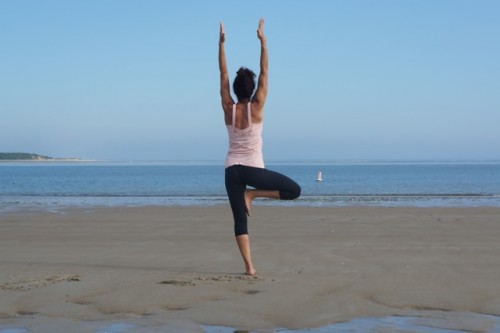
One of the themes you can use for class is one of balancing. I love this theme because it’s not only a physical theme but a spiritual theme as well. It’s spiritual in that we all strive for a life of balance as well as try to physically balance in our yoga practice. From an anatomical standpoint, balancing is a great way to not only create strength in the legs but also the core as well.
As teachers, when we teach balancing poses, it’s a combination of cueing to the foundation as well as the center line of the body. In anatomical terms, the phrase “axial extension” refers to extending along the axis of the body, which is the spine itself. As the spine has natural curves, it will never totally straighten but the idea is to engage the muscles that run along the sides of the spine, the erector spinae, and stretch as much as you can. This action become critical to balancing in any pose.
The second action has to do with the front line of the body. Just as the erector spinae runs along the spine in the back of the body, the rectus abdominus runs along the center line of the body in the front. Once you combine engaging the front and back lines of the body, you increase the stability of the pose.
The last piece is the foundation. From a teaching perspective. this should really be the first piece you cue because you want to teach from the ground up (one of the best pieces of advice I got from one of my teachers, Baron Baptiste). Once you start looking at your student’s feet, you’ll see all sorts of variation. The most common challenge is if the foot is not straight, meaning “straight ahead.” You need to be sure that the student sets up the foot so the toes point forward (as in anatomical position). The second issue is to be sure that the student is rooting into all 4 corners of the feet. This is harder to see and is more of a sensation someone experiences but it’s good to speak to, regardless. The last piece is to avoid locking the knees and instead engage the quadriceps, which is a much more active position for the leg and safer for the knee joint.
As you teach any pose, it’s always nice to mix in speaking to the physical as well as the spiritual. You might not do this all the time but in balancing poses, there are some logical themes that come up. Letting go of perfection, (as in, you might fall but so what?) standing in your strength, lifting your heart…. these are all things that come to mind when you teach a balance. Let your intuition and authentic nature guide your cueing. Think of phrases that come to your mind as you’re in a balancing pose. Chances are, that is a good place to start in terms of what you might say.
Poses for this theme include Eagle, Tree, Dancer’s Pose, Hand to Big Toe and Half Moon.
As always, give students space to be in their own experience and guide them along the way.

Beautiful inspiration!!!!
Julia, glad you liked it! Karen